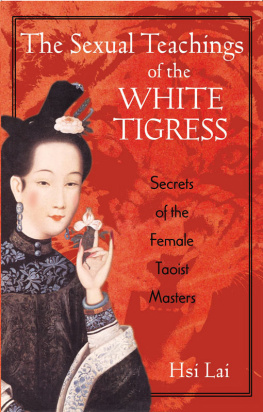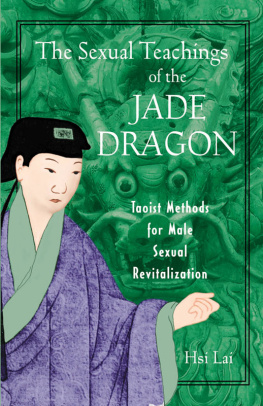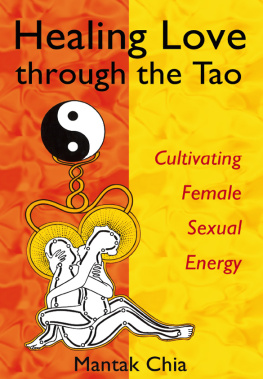

Taoist Sexual Secrets for Youthful Restoration
and Spiritual Illumination
Hsi Lai

Valley Spirit Arts
Phoenix, Arizona
Other books by the author
The Sexual Teachings of the White Tigress:
Secrets of the Female Taoist Masters
The Sexual Teachings of the Jade Dragon:
Taoist Methods for Male Sexual Revitalization
Disclaimer
The contents and practices described in this book are intended for the sole purposes of entertainment and study. None of the practices should be undertaken without supervision and great caution. It is advised to consult a health professional or doctor before engaging in any of the practices mentioned in this work.
Also, the reader should not make the assumption that these teachings and practices are indicative of typical Asian culture or sexual behaviors. These teachings and practices only apply to a very small segment of Asians and therefore it would be remiss to make any general assumptions about Chinese or any other cultures sexual behavior and practices.
Copyright 2006, 2015 by Hsi Lai.
First edition published by Tao Traditions Incorporated in 2006. New edition by Valley Spirit Arts, All rights reserved. No part of this book may be reproduced or utilized in any form or by any means, electronic or mechanical, including photocopying, recording, or by any information storage and retrieval system, without prior written permission from the author and Valley Spirit Arts or Tao Traditions Incorporated.
Library of Congress Control Number: 2006928561
ISBN-13: 978-1-5173-4108-4
ISBN-10: 1-5173-4108-6
Published by Valley Spirit Arts
www.valleyspiritarts.com
Co-published by Tao Traditions Incorporated
www.taotraditions.com

Hsi Wangmu
Western Royal Mother
Note to the Reader
This book expands on information presented in the previous publications of The Sexual Teaching of the White Tigress and The Sexual Teachings of the Jade Dragon by providing more detailed information on the sexual practices of the White Tigress and Green Dragon in contemporary and practical terms. These three works are intrinsically connected.
Even though much of this work appears to be directed towards women, it is equally valuable for both genders. The more understanding each gender has of the other the greater will be their sexual energy, experiences, and harmony. So, no matter your gender, studying this book will prove beneficial.
Acknowledgements
I first want to thank the readers of my earlier works for all their supportive and kind words about the teachings. Without their validations and encouragements, this book, or any future volumes, would not be possible.
My deepest heartfelt thanks to Madame Lin, who quietly left this world in August 2014, for allowing and trusting me to enter so deeply into the private world of the White Tigress. Even though thirty years has passed, my memories of her kindness in sharing her knowledge are still very lucid, as is my gratitude to her.
My deepest thanks to Narmada Singh for his financial support in helping produce this new edition, both for the hard copy and eBook formats.
Lastly, but certainly not least, to all my colleagues and friends at the White Tigress Society (Tao Traditions), Dao Vital Energies, and Valley Spirit Arts, my deepest thanks to them for their patience and support. The whole notion of promoting a teaching rooted in the ethos of secrecy is very much like entering an immense dark cave with but a small flashlight to navigate their way, and they must be highly commended for granting this old tortoise of a Taoist the freedom to drag his tail in the mud.
To all the above, and to all those who have taken the time to write me over the years with their kind support, I bow in deepest gratitude.
Xi Lai Bai Hu
Autumn, 2015
Glossary of Special Terms
Explanations of the following terms have been provided in order to make the reading of this book clearer to those readers who do not have a background in Chinese history, language, or culture. Normally, a glossary is placed as an appendix to a book, but in connection with this material it is important readers have some knowledge of these terms beforehand.
Taoism
Taoism, the first of Chinas two indigenous philosophies, dates back more than five thousand years. Confucianism developed much later in Chinese history. Taoism has long permeated Chinese social, political, artistic, musical, and religious life, even into present times. Taoism is predicated on adhering to the natural workings and forces of Tao and nature, and those who successfully achieve this union become sages (cheng) , true men (chen jen) , or immortals (hsien) . The main difference between these two philosophies is that Taoism predicated itself on the ideal of attaining physical or spiritual immortality, and Confucianism solely on biological immortality through posterity of male lineages.
White Tigress
In Chinese culture, the term White Tigress can be defined in several ways. The most popular being the power inherent of a female with a hairless vagina. In this book, however, the term has the added meaning of a female who follows the natural workings and forces of her sexuality to achieve beauty, youthfulness, longevity, and immortality.
Even though there are no formal Taoist lineages of the White Tigress in Chinese teachings, her sexual and hygienic practices all derived from teachings passed down through various consorts, concubines, and female Taoist nuns and immortals. The matriarch of the White Tigress is Hsi Wangmu (Western Royal Mother), who dates back in Chinese history to circa 3000 B.C. Certain sexual sects in Chinese history emulated some of the White Tigress teachings, such as The White Tiger, Green Dragon Sect; The Yellow and White Sect; The Red and White Sect; and The Dragon and Tiger Sect. These groups were more male dominated, however, and only adhered to portions of the teachings handed down from Western Royal Mother.
Immortaless
This term has three basic meanings: One, it refers to a woman who cultivates her Three Treasures (sexual energy, qi, and spirit) and attains youthfulness and longevity. Two, to a woman who cultivates her Three Treasures and experiences full consciousness at death, who can then direct her spirit to wherever she pleases. Three, it denotes a woman who cultivates her Three Treasures and attains everlasting physical life and youthfulness.
Concubine
Refers to a secondary wife or wives, depending on the wealth of the man who could maintain any number of concubines from one to hundreds. The primary reason for concubines is seen in the Confucian ideal of biological immortality, meaning the posterity of having sons to carry a bloodline. Some concubines led very comfortable lives and received excellent educations in various arts and fields. Most did not, however, and they led very toiled and abused lives.
Next page











